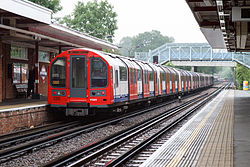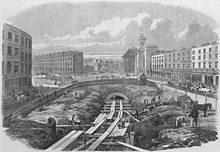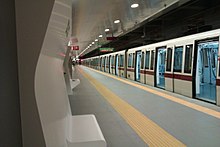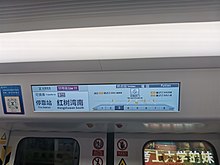Rapid transit
This article possibly contains original research. (April 2022) |



Metro in one city
Metro in two or more cities
Metro under construction
Planned metro
No metro
Rapid transit or mass rapid transit (MRT), also known as heavy rail or metro, is a type of high-capacity
Modern services on rapid transit systems are provided on designated lines between
The world's first rapid transit system was the partially underground Metropolitan Railway which opened in 1863 using steam locomotives, and now forms part of the London Underground.[8] In 1868, New York opened the elevated West Side and Yonkers Patent Railway, initially a cable-hauled line using static steam engines.
As of 2021[update], China has the largest number of rapid transit systems in the world—40 in number,[9] running on over 4,500 km (2,800 mi) of track—and was responsible for most of the world's rapid-transit expansion in the 2010s.[10][11][12] The world's longest single-operator rapid transit system by route length is the Shanghai Metro.[13][14] The world's largest single rapid transit service provider by number of stations (472 stations in total)[15] is the New York City Subway. The busiest rapid transit systems in the world by annual ridership are the Shanghai Metro, Tokyo subway system, Seoul Metro and the Moscow Metro.
Terminology
| Part of a series on |
| Rail transport |
|---|
 |
|
|
| Infrastructure |
|
|
| Service and rolling stock |
|
| Special systems |
|
|
| Miscellanea |
|
|


The term Metro is the most commonly used term for underground rapid transit systems used by non-native English speakers. overhead, overground or Hochbahn in German. One of these terms may apply to an entire system, even if a large part of the network, for example, in outer suburbs, runs at ground level.
In most of
Various terms are used for rapid transit systems around North America. The term metro is a shortened reference to a metropolitan area. Rapid transit systems such as the Washington Metro, Los Angeles Metro Rail, the Miami Metrorail, and the Montreal Metro are generally called the Metro. In Philadelphia, the term "El" is used for the Market–Frankford Line which runs mostly on an elevated track, while the term "subway" applies to the Broad Street Line which is almost entirely underground. Chicago's commuter rail system that serves the entire metropolitan area is called Metra (short for Metropolitan Rail), while its rapid transit system that serves the city is called the "L". Boston's subway system is known locally as "The T". In the San Francisco Bay Area, residents refer to Bay Area Rapid Transit by its acronym "BART".[22][23]
The New York City Subway is referred to simply as "the subway", despite 40% of the system running above ground. The term "L" or "El" is not used for elevated lines in general as the lines in the system are already designated with letters and numbers. The "L" train or L (New York City Subway service) refers specifically to the 14th Street–Canarsie Local line, and not other elevated trains. Similarly, the Toronto Subway is referred to as "the subway", with some of its system also running above ground. These are the only two North American systems that are called "subways".
In most of Southeast Asia and in Taiwan, rapid transit systems are primarily known by the acronym MRT. The meaning varies from one country to another. In Indonesia, the acronym stands for Moda Raya Terpadu or Integrated Mass [Transit] Mode in English.[24] In the Philippines, it stands for Metro Rail Transit.[25] Two underground lines use the term subway. In Thailand, it stands for Metropolitan Rapid Transit, previously using the Mass Rapid Transit name.[26] Outside of Southeast Asia, Kaohsiung and Taoyuan, Taiwan have their own MRT systems which stands for Mass Rapid Transit, as with Singapore.[27][28][29]
History

The opening of London's steam-hauled
In 1890, the
The technology quickly spread to other cities in Europe, the United States, Argentina, and Canada, with some railways being converted from steam and others being designed to be electric from the outset. Budapest, Chicago, Glasgow, Boston and New York City all converted or purpose-designed and built electric rail services.[33]
Advancements in technology have allowed new automated services. Hybrid solutions have also evolved, such as tram-train and premetro, which incorporate some of the features of rapid transit systems.[30] In response to cost, engineering considerations and topological challenges some cities have opted to construct tram systems, particularly those in Australia, where density in cities was low and suburbs tended to spread out.[34] Since the 1970s, the viability of underground train systems in Australian cities, particularly Sydney and Melbourne, has been reconsidered and proposed as a solution to over-capacity. Melbourne had tunnels and stations developed in the 1970s and opened in 1980. The first line of the Sydney Metro was opened in 2019.[35]
Since the 1960s, many new systems were introduced in Europe, Asia and Latin America.[19] In the 21st century, most new expansions and systems are located in Asia, with China becoming the world's leader in metro expansion, operating some of the largest and busiest systems while possessing almost 60 cities that are operating, constructing or planning a rapid transit system.[36][37]
Operation

Rapid transit is used for local transport in
Some systems may extend only to the limits of the inner city, or to its inner ring of suburbs with trains making frequent station stops. The outer suburbs may then be reached by a separate commuter rail network where more widely spaced stations allow higher speeds. In some cases the differences between urban rapid transit and suburban systems are not clear.[4]
Rapid transit systems may be supplemented by other systems such as trolleybuses, regular buses, trams, or commuter rail. This combination of transit modes serves to offset certain limitations of rapid transit such as limited stops and long walking distances between outside access points. Bus or tram feeder systems transport people to rapid transit stops.[38]
Lines



Each rapid transit system consists of one or more lines, or circuits. Each line is serviced by at least one specific route with trains stopping at all or some of the line's stations. Most systems operate several routes, and distinguish them by colors, names, numbering, or a combination thereof. Some lines may share track with each other for a portion of their route or operate solely on their own right-of-way. Often a line running through the city center forks into two or more branches in the suburbs, allowing a higher service frequency in the center. This arrangement is used by many systems, such as the Copenhagen Metro,[42] the Milan Metro, the Oslo Metro, the Istanbul Metro and the New York City Subway.[43]
Alternatively, there may be a single central terminal (often shared with the central railway station), or multiple interchange stations between lines in the city center, for instance in the
The capacity of a line is obtained by multiplying the car capacity, the train length, and the
Network topologies
Rapid transit topologies are determined by a large number of factors, including geographical barriers, existing or expected travel patterns, construction costs, politics, and historical constraints. A transit system is expected to serve an area of land with a set of lines, which consist of shapes summarized as "I", "L", "U", "S", and "O" shapes or loops. Geographical barriers may cause chokepoints where transit lines must converge (for example, to cross a body of water), which are potential congestion sites but also offer an opportunity for transfers between lines.[50]
Ring lines provide good coverage, connect between the radial lines and serve tangential trips that would otherwise need to cross the typically congested core of the network. A rough grid pattern can offer a wide variety of routes while still maintaining reasonable speed and frequency of service.[50] A study of the 15 world largest subway systems suggested a universal shape composed of a dense core with branches radiating from it.[51]
-
Cross, e.g.Kaohsiung, Kyoto, Nagpur, Nizhny Novgorod, Panama City, Philadelphia (SEPTA), Pyongyang, Rotterdam, Sendai, Warsaw
-
X-shaped, e.g.
-
Radial, e.g.Washington DC
Passenger information

Rapid transit operators have often built up strong

A transit map is a topological map or schematic diagram used to show the routes and stations in a public transport system. The main components are color-coded lines to indicate each line or service, with named icons to indicate stations. Maps may show only rapid transit or also include other modes of public transport.[53] Transit maps can be found in transit vehicles, on platforms, elsewhere in stations, and in printed timetables. Maps help users understand the interconnections between different parts of the system; for example, they show the interchange stations where passengers can transfer between lines. Unlike conventional maps, transit maps are usually not geographically accurate, but emphasize the topological connections among the different stations. The graphic presentation may use straight lines and fixed angles, and often a fixed minimum distance between stations, to simplify the display of the transit network. Often this has the effect of compressing the distance between stations in the outer area of the system, and expanding distances between those close to the center.[53]
Some systems assign unique
The Seoul Metro is another example that utilizes a code for its stations. Unlike that of Singapore's MRT, it is mostly numbers. Based on the line number, for example Sinyongsan station, is coded as station 429. Being on Line 4, the first number of the station code is 4. The last 2 numbers are the station number on that line. Interchange stations can have multiple codes. Like City Hall station in Seoul which is served by Line 1 and Line 2. It has a code of 132 and 201 respectively. The Line 2 is a circle line and the first stop is City Hall, therefore, City Hall has the station code of 201. For lines without a number like Bundang line it will have an alphanumeric code. Lines without a number that are operated by KORAIL will start with the letter 'K'.
With widespread use of the
Safety and security


Compared to other modes of transport, rapid transit has a good safety record, with few accidents. Rail transport is subject to strict safety regulations, with requirements for procedure and maintenance to minimize risk. Head-on collisions are rare due to use of double track, and low operating speeds reduce the occurrence and severity of rear-end collisions and derailments. Fire is more of a danger underground, such as the King's Cross fire in London in November 1987, which killed 31 people. Systems are generally built to allow evacuation of trains at many places throughout the system.[55][56]
High platforms, usually over 1 meter / 3 feet, are a safety risk, as people falling onto the tracks have trouble climbing back. Platform screen doors are used on some systems to eliminate this danger.
Rapid transit facilities are public spaces and may suffer from
Some subway systems, such as the
Added features

Some rapid transport trains have extra features such as wall sockets, cellular reception, typically using a leaky feeder in tunnels and DAS antennas in stations, as well as Wi-Fi connectivity. The first metro system in the world to enable full mobile phone reception in underground stations and tunnels was Singapore's Mass Rapid Transit (MRT) system, which launched its first underground mobile phone network using AMPS in 1989.[61] Many metro systems, such as the Hong Kong Mass Transit Railway (MTR) and the Berlin U-Bahn, provide mobile data connections in their tunnels for various network operators.
Infrastructure


The technology used for public, mass rapid transit has undergone significant changes in the years since the Metropolitan Railway opened publicly in London in 1863.[3][4]
High capacity
Some systems have been built from scratch, others are reclaimed from former commuter rail or suburban tramway systems that have been upgraded, and often supplemented with an underground or elevated downtown section.
Trains
Most rapid transit trains are
Some urban rail lines are built to a
Historically, rapid transit trains used ceiling fans and openable windows to provide fresh air and piston-effect wind cooling to riders. From the 1950s to the 1990s (and in most of Europe until the 2000s), many rapid transit trains from that era were also fitted with forced-air ventilation systems in carriage ceiling units for passenger comfort. Early rapid transit rolling stock fitted with air conditioning, such as the Hudson and Manhattan Railroad K-series cars[67] from 1958, the New York City Subway R38 and R42 cars from the late-1960s, and the Nagoya Municipal Subway 3000 series, Osaka Municipal Subway 10 series[68] and MTR M-Train EMUs from the 1970s, were generally only made possible largely due to the relatively generous loading gauges of these systems and also adequate open-air sections to dissipate hot air from these air conditioning units. Especially in some rapid transit systems such as the Montreal Metro[69] (opened 1966) and Sapporo Municipal Subway (opened 1971), their entirely enclosed nature due to their use of rubber-tyred technology to cope with heavy snowfall experienced by both cities in winter precludes any air-conditioning retrofits of rolling stock due to the risk of heating the tunnels to temperatures that would be too hot for passengers and for train operations.
In many cities, metro networks consist of lines operating different sizes and types of vehicles. Although these sub-networks may not often be connected by track, in cases when it is necessary, rolling stock with a smaller loading gauge from one sub network may be transported along other lines that use larger trains. On some networks such operations are part of normal services.
Tracks
Most rapid transit systems use conventional
An alternate technology, using
Some cities with steep hills incorporate mountain railway technologies in their metros. One of the lines of the Lyon Metro includes a section of rack (cog) railway, while the Carmelit, in Haifa, is an underground funicular.
For elevated lines, another alternative is the
Motive power
Although trains on very early rapid transit systems like the
The use of overhead wires allows higher power supply
Tunnels
At subterranean levels,
The construction of an underground metro is an expensive project and is often carried out over a number of years. There are several different methods of building underground lines.
In one common method, known as
Another tunneling method is called
A disadvantage with this, is that the cost of tunneling is much higher than building cut-and-cover systems, at-grade or elevated. Early tunneling machines could not make tunnels large enough for conventional railway equipment, necessitating special low, round trains, such as are still used by most of the London Underground. It cannot install air conditioning on most of its lines because the amount of empty space between the trains and tunnel walls is so small. Other lines were built with cut-and-cover and have since been equipped with air-conditioned trains.
The deepest metro system in the world was built in

- Deepest stations:
- Arsenalna station in Kyiv Metro, Ukraine (105.5 metres (346 ft), opened 1960, built under a hill)
- Admiralteyskaya (The Admiralty, 102 metres (335 ft), opened 2011, probably the best candidate)
- Hongtudi station in Chongqing Metro, China (94 metres (308 ft), opened in 2016)
- Liyuchi station in Chongqing Metro, China (76 metres (249 ft), opened in 2017)
- Park Pobedy station in Moscow (~80 metres (260 ft), opened 2005, built under a hill)
- nuclear shelter)
- Washington Park MAX Light Railstation in Portland, Oregon, US (built under a hill), 260 feet (80 m)
An advantage of deep tunnels is that they can dip in a basin-like profile between stations, without incurring the significant extra costs associated with digging near ground level. This technique, also referred to as putting stations "on humps", allows gravity to assist the trains as they accelerate from one station and brake at the next. It was used as early as 1890 on parts of the City and South London Railway and has been used many times since, particularly in Montreal.
The
Elevated railways
Stations

Stations function as hubs to allow passengers to board and disembark from trains. They are also payment checkpoints and allow passengers to transfer between modes of transport, for instance to buses or other trains. Access is provided via either island- or side platforms.[74] Underground stations, especially deep-level ones, increase the overall transport time: long escalator rides to the platforms mean that the stations can become bottlenecks if not adequately built. Some underground and elevated stations are integrated into vast underground or skyway networks respectively, that connect to nearby commercial buildings.[75] In suburbs, there may be a "park and ride" connected to the station.[76]
To allow easy access to the trains, the platform height allows step-free access between platform and train. If the station complies with accessibility standards, it allows both disabled people and those with wheeled baggage easy access to the trains,[77] though if the track is curved there can be a gap between the train and platform. Some stations use platform screen doors to increase safety by preventing people falling onto the tracks, as well as reducing ventilation costs.
Particularly in the former Soviet Union and other Eastern European countries, but to an increasing extent elsewhere, the stations were built with splendid decorations such as marble walls, polished granite floors and mosaics—thus exposing the public to art in their everyday life, outside galleries and museums. The systems in Moscow, St. Petersburg, Tashkent and Kyiv are widely regarded as some of the most beautiful in the world.[78] Several other cities such as London,[79] Stockholm, Montreal, Lisbon, Naples and Los Angeles have also focused on art, which may range from decorative wall claddings, to large, flamboyant artistic schemes integrated with station architecture, to displays of ancient artifacts recovered during station construction.[80] It may be possible to profit by attracting more passengers by spending relatively small amounts on grand architecture, art, cleanliness, accessibility, lighting and a feeling of safety.[81]
Crew size and automation

In the early days of underground railways, at least two staff members were needed to operate each train: one or more attendants (also called "

A replacement system for human drivers became available in the 1960s, with the advancement of
In normal operation, a crew member sits in the driver's position at the front, but is only responsible for closing the doors at each station. By pressing two "start" buttons the train would then move automatically to the next station. This style of "semi-automatic train operation" (STO), known technically as "
A variant of ATO, "driverless train operation" (DTO) or technically "GoA 3", is seen on some systems, as in London's Docklands Light Railway, which opened in 1987. Here, a "passenger service agent" (formerly called "train captain") would ride with the passengers rather than sit at the front as a driver would, but would have the same responsibilities as a driver in a GoA 2 system. This technology could allow trains to operate completely automatically with no crew, just as most elevators do. When the initially increasing costs for automation began to decrease, this became a financially attractive option for the operators.
At the same time, countervailing arguments stated that in an
Completely unstaffed trains, or "unattended train operation" (UTO) or technically "GoA 4", are more accepted on newer systems where there are no existing crews to be displaced, and especially on

Systems that use automatic trains also commonly employ full-height
As for larger trains, the Paris Métro has human drivers on most lines but runs automated trains on its newest line, Line 14, which opened in 1998. The older Line 1 was subsequently converted to unattended operation by 2012, and it is expected that Line 4 will follow by 2023.[82] The North East MRT line in Singapore, which opened in 2003, is the world's first fully automated underground urban heavy-rail line. The MTR Disneyland Resort line is also automated, along with trains on the South Island line.
Modal tradeoffs and interconnections

Since the 1980s,
A
Suburban
Some cities have opted for two tiers of urban railways: an urban rapid transit system (such as the
In some cases, such as the
Costs, benefits, and impacts

As of March 2018[update], 212 cities have built rapid transit systems.
Elevated or underground systems in city centers allow the transport of people without occupying expensive land, and permit the city to develop compactly without physical barriers.
Rapid transit systems have high
The
Urban land-use planning policies are essential for the success of rapid transit systems, particularly as mass transit is not feasible in low-density communities. Transportation planners estimate that to support rapid rail services, there must be a residential housing density of twelve dwelling units per acre.[94]
See also
- List of metro systems
- Bus rapid transit
- Megaproject
- Personal rapid transit
- Rapid transit track gauge
References
Citations
- ^ www.urbanrail.net
- ^ "Rapid transit". Merriam-Webster. Archived from the original on 2013-07-20. Retrieved 2013-07-31.
- ^ a b UITP (2011). "Recommended basic reference for developing a minimum set of standards for voluntary use in the field of urban rail, according to mandate M/486" (PDF). Archived from the original (PDF) on 2014-02-22. Retrieved 2014-02-16.
- ^ a b c "Glossary of Transit Terminology" (PDF). American Public Transportation Association. Archived (PDF) from the original on 2013-05-12. Retrieved 2013-07-31.
- ^ S2CID 154931412. Retrieved 2 April 2023.
- ^ a b "Rapid Transit". Encyclopædia Britannica. Archived from the original on 2014-10-17. Retrieved 2014-11-28.
- ^ "Chicago". Archived from the original on 2015-04-16. Retrieved 2015-04-24.
- ISBN 978-0-904711-30-1. Archived from the originalon 2013-01-16. Retrieved 2013-01-02.
- ^ "Luoyang and Ji'nan open metro lines". International Railway Journal. 2021-03-29. Retrieved 2021-06-07.
- ^ "China's Metro Boom Continues to Drive Rapid Transit Growth – Institute for Transportation and Development Policy". Institute for Transportation and Development Policy. 2018-07-30. Archived from the original on 2018-11-20. Retrieved 2018-11-20.
- ^ "Metro Data". metro-data.info. Archived from the original on 2018-09-29. Retrieved 2018-09-28.
- ^ "Rapid Transit Trends Show Record Growth in 2016, with Huge Increases in China, Brazil – Institute for Transportation and Development Policy". Institute for Transportation and Development Policy. 2017-02-17. Archived from the original on 2018-10-23. Retrieved 2018-11-20.
- ^ "Shanghai now the world's longest metro". Railway Gazette International. 4 May 2010. Archived from the original on 15 May 2010. Retrieved 2010-05-04.
- ^ Smith, Stephen J. (6 January 2014). "New Starts: Shanghai Metro World's Longest, Panama Canal Drama, Japan's Maglev". Next City. Archived from the original on 25 September 2014. Retrieved 2014-09-21.
- ^ "Facts – Subway and Bus Ridership". Metropolitan Transportation Authority (MTA). Archived from the original on 2014-09-12. Retrieved 2014-09-21.
- ^ Fjellstrom&Wright, 2002: p.2
- ISBN 978-0-618-08230-8.
- ^ "Definition of "Underground"". Chambers Reference Online. Archived from the original on 2007-09-30. Retrieved 2006-11-28.
- ^ a b White, 2002: 63
- ^ a b Ovenden, 2007: 93
- ^ Ovenden, 2007: 16
- CNN. 2013-11-03. Archivedfrom the original on 2016-01-24. Retrieved 2015-07-20.
- ^ "Transportation Basics: How to Use BART". San Francisco Travel. Retrieved 2022-11-03.
- ^ "Tarif Belum Diketok, Warga Masih Bisa Nikmati MRT Cuma-cuma Sampai Akhir Maret". Merdeka.com (in Indonesian). Retrieved 2017-12-22.
- ^ "About Us – MRT3 Stations". Metro Rail Transit. Archived from the original on 2013-01-22. Retrieved 2014-06-08.
- ^ "BEM Investor presentation" (PDF).
- ^ 桃園都會區大眾捷運系統 (in Chinese). Department of Rapid Transit Systems. 2008-07-01. Archived from the original on 2011-04-05. Retrieved 2010-06-19.
- ^ KMRT History - Kaohsiung City Mass Rapid Transit Bureau official site (Traditional Chinese) Archived 2014-08-19 at the Wayback Machine
- ^ Seah C. M. (1981). Southeast Asian Affairs. Singapore: Institute of Southeast Asian Studies. p. 293.
- ^ a b c Ovenden, 2007: 7
- ISBN 978-0-74780-790-2.
- ^ Bolger, Paul (2004-11-22). "Site Name: Liverpool Overhead Railway & Dingle Station". Subterranea Britannica. Archived from the original on 2012-11-22. Retrieved 2007-09-19.
- ^ "Subway". Encyclopædia Britannica online. Archived from the original on 2006-12-20. Retrieved 2006-12-02.
- ^ a b Pulling, Niel (2008-05-22). "Light Rail – the Solution to Inner-City Chaos?". Railway Technology. Archived from the original on 2012-02-29. Retrieved 2008-08-18.
- ^ "Australia's first metro system opened in Sydney". Urban Transport Magazine. 2019-05-29. Retrieved 2021-04-03.
- ^ "Rapid Transit Trends Show Record Growth in 2016, with Huge Increases in China, Brazil – Institute for Transportation and Development Policy". Institute for Transportation and Development Policy. 2017-02-17. Archived from the original on 2018-08-05. Retrieved 2018-09-01.
- ^ "In response to growth, Chinese cities choose metros". The Transport Politic. 2018-01-17. Archived from the original on 2018-09-07. Retrieved 2018-09-01.
- ^ Cervero, 1998: 13
- ^ "Helsinki Metro – Discover Helsinki". 19 March 2019. Archived from the original on 2020-07-06. Retrieved 2020-07-04.
- ^ "Today in Transportation History – 1982: The Northernmost Public Transportation System". 2 August 2017. Archived from the original on 2020-07-05. Retrieved 2020-07-04.
- ^ "8 charming pictures from Helsinki's metro". Archived from the original on 2020-07-04. Retrieved 2020-07-04.
- ^ Ovenden, 2007: 84
- ^ Ovenden, 2007: 32–35
- ^ Ovenden, 2007: 95
- ^ Ovenden, 2007: 28–31
- ^ Ovenden, 2007: 36–39
- ^ "MTR > A Service of World-class Quality". www.mtr.com.hk. Retrieved 2021-06-27.
- ISBN 978-1138361959.
- ^ White, Peter (2002). Public Transport: Its Planning, Management, and Operation. Spon Press. pp. 65–66.
- ^ ISBN 978-1-59726-972-8.
- PMID 22593096.
- ^ Ovenden, 2007: 107
- ^ a b Ovenden, 2007: 9
- ^ Ström, 1998: 58
- ^ Office of Hazardous Materials Safety. "A Comparison of Risk: Accidental Deaths – United States – 1999–2003". US Department of Transportation. Archived from the original on 7 September 2007. Retrieved 2007-09-10.
- ^ "Office of Rail Regulation". UK Health & Safety Executive. Archived from the original on 2014-01-27. Retrieved 2007-09-10.
- ^ "Why we need to talk about sexual assault on public transport". 30 April 2017. Archived from the original on 6 January 2018. Retrieved 6 January 2018.
- ^ "Sexual Harassment on the New York Subway Has Increased More Than 50% This Year". Archived from the original on 2018-01-06. Retrieved 2018-01-06.
- ^ Needle et al., 1997: 10–13
- ^ "El auto de procesamiento por el 11-M". El Mundo (in Spanish). Archived from the original on 2008-12-20. Retrieved 2008-09-08.
- ^ "Supercharging Singapore". The Straits Times. 10 October 2015.
- ^ White, 2002: 64–65
- ^ a b Kjenstad, 1994: 46
- ^ a b White, 2002: 64
- ^ Railway Technology. "Toulouse Metro, France". Archived from the original on 2008-09-26. Retrieved 2008-08-20.
- .
- ^ "Hudson and Manhattan Railroad. Full issue of Electric Railroads, No. 27, Aug. 1959. Published by Electric Railroaders Assn., N.Y., N.Y. - Serial | Hoboken Historical Museum".
- ^ Tsuchiya, Takeyuki (7 July 2022). "昔の地下鉄は暑かった?車両「冷房化」の意外な歴史" [Was it hot in the old subway? Surprising history of vehicle "cooling"]. Mainichi Shimbun (in Japanese). Archived from the original on 6 July 2022. Retrieved 15 August 2022.
- ^ "Métro et autobus: chaud débat sur la climatisation" (in French). Ruefrontenac.com. January 27, 2009. Retrieved March 10, 2011.
- ISBN 978-2-921969-08-6. Archived from the original(PDF) on September 30, 2007.
- ^ "Docklands Light Railway – About DLR". Archived from the original on 27 October 2006. Retrieved 2006-12-04.
- ^ "Bangkok Mass Transit System Company Limited – BTS SkyTrain". Archived from the original on 2006-11-19. Retrieved 2006-12-04.
- ^ "Skyline Rail Operations". City and County of Honolulu. 9 January 2024. Retrieved 17 January 2024.
- ^ Uslan et al., 1990: 71
- ^ Cervero, 1998: 8
- ^ Cervero, 1998: 226
- S2CID 110192749.
- ^ "Metro Arts and Architecture". Metro Bits. Archived from the original on 2006-12-02. Retrieved 2006-12-04.
- ^ "Art on the Underground".
- ^ Storstockholms Lokaltrafik. "Konståkning i världens längsta konstutställning" (in Swedish). Archived from the original on October 13, 2007. Retrieved 2008-08-20.
- ^ "10 Ways to Enhance Your Community: Unleash the Power of Public Transportation" (PDF). Archived from the original (PDF) on 17 October 2006. Retrieved 2006-12-04.
- ^ Chicheportiche, Olivier (November 15, 2021). "Métro parisien: l'automatisation de la ligne 4 prendra du retard". BFM Business. Retrieved 14 February 2022.
- ^ White, 2002: 63–64
- ^ Cervero, 1998: 21
- ^ "World Metro Database". Metro Bits. Archived from the original on 2010-09-23. Retrieved 2013-11-17.
- ^ a b Banister and Berechman, 2000: 258
- ^ Cervero, 1998: 26
- S2CID 258327571.
- ^ European Conference of Ministers of Transport, 2003: 187
- .
- ^ a b MTR Corporation (2008-08-05). "Announcement of Unaudited Results for the Six Months Ended 30 June 2008" (PDF). Archived (PDF) from the original on 9 September 2008. Retrieved 2008-08-21.
- ^ "Taipei Rapid Transit Corporation '08 Annual Report" (PDF). Taipei Rapid Transit Corporation. p. 96. Archived (PDF) from the original on 2011-12-25. Retrieved 2010-07-06.
- ^ ":: Center for Urban Studies and Research". Archived from the original on 2011-07-25. Retrieved 2010-11-11.
- ^ Booth, Geoffrey; Leonard, Bruce; Pawlukiewicz, Michael. "Ten Principles for Reinventing America's Suburban Business Districts" (PDF). ULI Americas. Urban Land Institute. Retrieved 2021-07-26.
Sources
- Banister, David & Berechman, Joseph (2000). Transport Investment and Economic Development. Routledge. ISBN 978-0-419-25590-1.
- Bobrick, Benson (1981). Labyrinths of Iron: a[n] History of the World's Subways. New York: Newsweek Books. ISBN 0-88225-299-2.
- ISBN 978-1-55963-591-2.
- European Conference of Ministers of Transport (2003). Safe & Sustainable Transport. Paris: OECD Publishing. ISBN 978-92-821-1303-5.
- Fjellstrom, K.; Wright, L. (2002). "Mass Transit Options" (PDF). Sustainable Transport: A Sourcebook for Policy-Makers in Developing Cities. Deutsche Gesellschaft für Technische Zusammenarbeit. Archived from the original(PDF) on 2018-08-07. Retrieved 2009-07-09.
- Kjenstad, Rune (1994). På skinner i Bymarka (in Norwegian). Oslo: Baneforlaget. ISBN 978-82-91448-01-5.
- ISBN 978-0-14-311265-5.
- Needle, Jerome A.; Transportation Security Board & Cobb, Renée M. (1997). Improving Transit Security. Transportation Security Board. ISBN 978-0-309-06013-4.
- Ström, Marianne (1998). Metro Art. ACR Edition. ISBN 978-2-86770-068-2.
- White, Peter (2002). Public Transport: Its Planning, Management, and Operation. Taylor & Francis. ISBN 978-0-415-25772-5.
- Uslan, Mark; ISBN 978-0-89128-166-5.
- Joseph P. Pickert; et al., eds. (2000). The American Heritage Dictionary of the English Language (4th ed.). Houghton Mifflin Company. ISBN 978-0-618-08230-8.
External links
- Databases
- Metro-Data.info (Archived 2018-09-29 at the Wayback Machine) – database of metro systems around the world












